Writer Patrick White (1912–1990) met Manoly Lascaris (1912–2003) at a party in Alexandria, Egypt in 1941. They were 29. White was serving as an intelligence officer with the Royal Air Force, and Lascaris was waiting to join the Royal Greek Army. The acquaintance who introduced them thought it wouldn't last, and White conceded that 'there were the added complications of a secret society that convention forced us to join'. Despite this, they lived together in Cairo after the war ended and then returned to Australia and settled at Dogwoods, a farm at Castle Hill north-west of Sydney, in 1948. White's third novel, The Aunt's Story, was published that year, but sales of it were so poor that he wondered whether he'd write any more novels and set about making a living from the farm instead. They bred schnauzers, and sold flowers, milk, cream and vegetables. The next three of White's novels – The Tree of Man, Voss, and Riders in the Chariot – were published between 1955 and 1961. In 1963 the couple moved to a house at Centennial Park. In addition to plays, screenplays and the autobiography Flaws in the Glass, White produced volumes of short stories and poetry and a further seven novels including The Eye of the Storm, A Fringe of Leaves and The Vivisector between 1964 and 1987. He was awarded the Nobel Prize for Literature in 1973. The Australian of the Year for 1974, White was one of the first six people to be named a Companion of the Order of Australia when the Australian honours system came into being in 1975. Increasingly disillusioned by Australia's superficiality and complacency, however, he rejected the honour following the dismissal of the Whitlam government, and remained outspoken on various social and political issues for the rest of his life.
White once described Lascaris as 'this small Greek of immense moral strength, who became the central mandala in my life's hitherto messy design', and their partnership lasted until his death in 1990. 'Patrick made me happy at once,' Lascaris recollected of their meeting 50 years earlier, 'and I think I made Patrick happy.' Lascaris remained in the Centennial Park house up until a few months before his own death in 2003.
Gift of Danina Dupain Anderson 2018. Donated through the Australian Government's Cultural Gifts Program.
© Max Dupain/Copyright Agency, 2024
The black and white photographic portrait of Patrick White and Manoly Lascaris was taken in 1987 by Max Dupain. It is a gelatin silver photograph on paper, measuring about 28 cm high by 25 cm wide, surrounded by a wide white border and simple wooden frame. White, and Lascaris, with his arm around a small dog, sit outside beneath a shady arbour.
In the background, light radiates through foliage which is visible above a low white brick-wall. In front is a row of assorted potted plants including a large spiky grass in a half wine barrel between the two figures. A wooden-framed pergola covered by a dense vine obscures the sky overhead.
In the left foreground Lascaris is perched on a weathered wooden table. He is in profile, facing towards our right. His forehead is lined, hair receding in patches of untidy grey-and-white wisps. His eyes are hidden behind large dark glasses. Light reflects off the lenses. Lascaris’ lips are closed and the skin on his neck sags down from his chin into the open collar of his light-coloured button-up shirt.
Lascaris’ arm, sleeve rolled up at the elbow, encircles a small dog, sitting, nestled to his hip. The dog has a short smooth white coat with darker markings. Its head, with little pointed ears and muzzle, is bent down to Lascaris’ hand, palm flat on the table. Behind the dog Lascaris’ legs are swiveled to his left, towards White.
White sits on the right, further back in the scene. His body is left-side on, while his head, almost sinking into his shoulders, is turned forward towards Lascaris. He has thinning white hair combed over his head. His forehead has deep lines etched across it and his eyebrows are drawn together. His eyes are dark and his gaze is lowered to the right of the scene. White’s mouth is a thin downturned arc. He wears a dark open-necked shirt with short sleeves. A pen is suspended from a cord around his neck. White's forearms rest on his simple white metal-framed chair.
On his right wrist he has a slim watch and his hand touches the stem of a walking stick leaning between his legs, its dark wooden handle curved against his lap. White’s left hand hangs loosely from the arm of the chair. He wears pale trousers and his knees and lower legs are concealed behind the table Lascaris sits upon.
Audio description written and voiced by Lucie Shawcross, 2021
Max Dupain OBE (age 76 in 1987)
Patrick White (age 75 in 1987)
Manoly Lascaris (age 75 in 1987)
Danina Dupain Anderson (47 portraits)



On one level The Companion talks about the most famous and frontline Australians, but on another it tells us about ourselves.
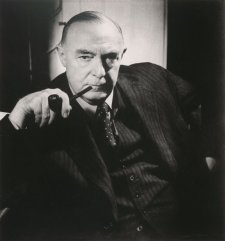
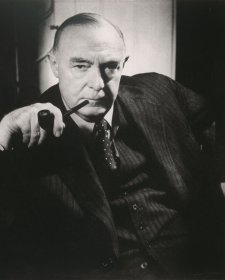
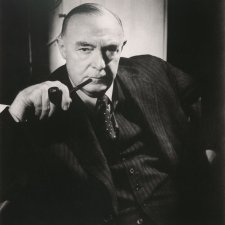
Johanna McMahon revels in history and mystery in pursuit of a suite of unknown portrait subjects.
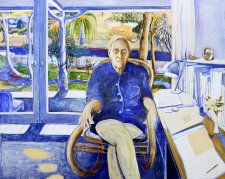
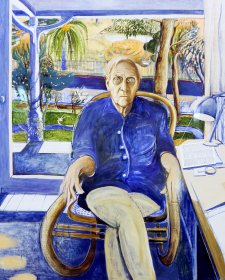
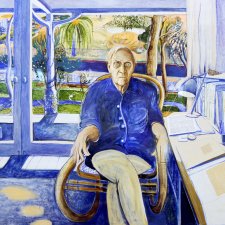
Sarah Engledow describes the fall-out once Brett Whiteley stuck Patrick White’s list of his loves and hates onto his great portrait of the writer.